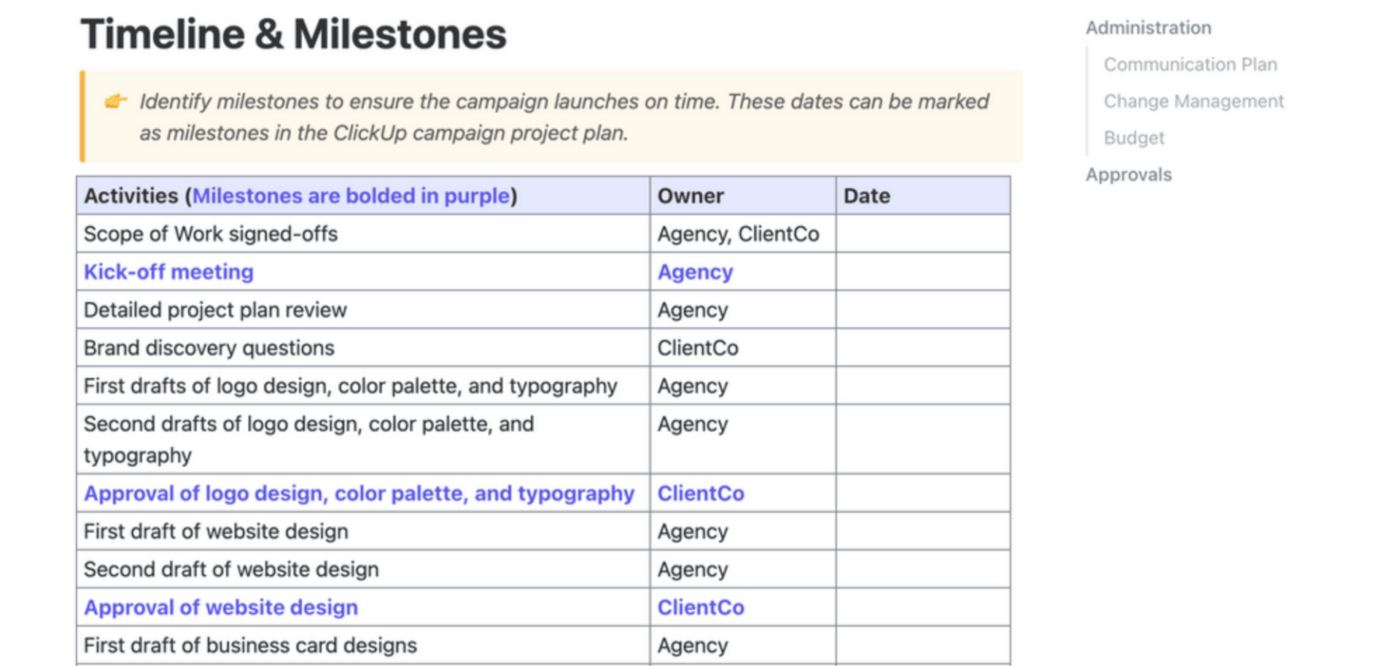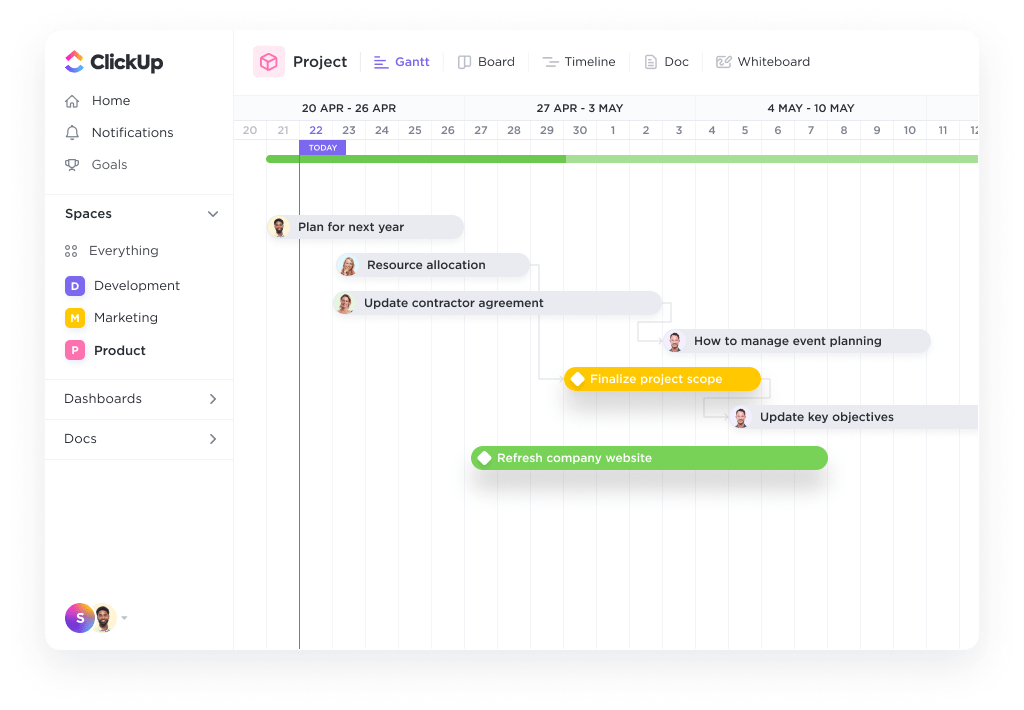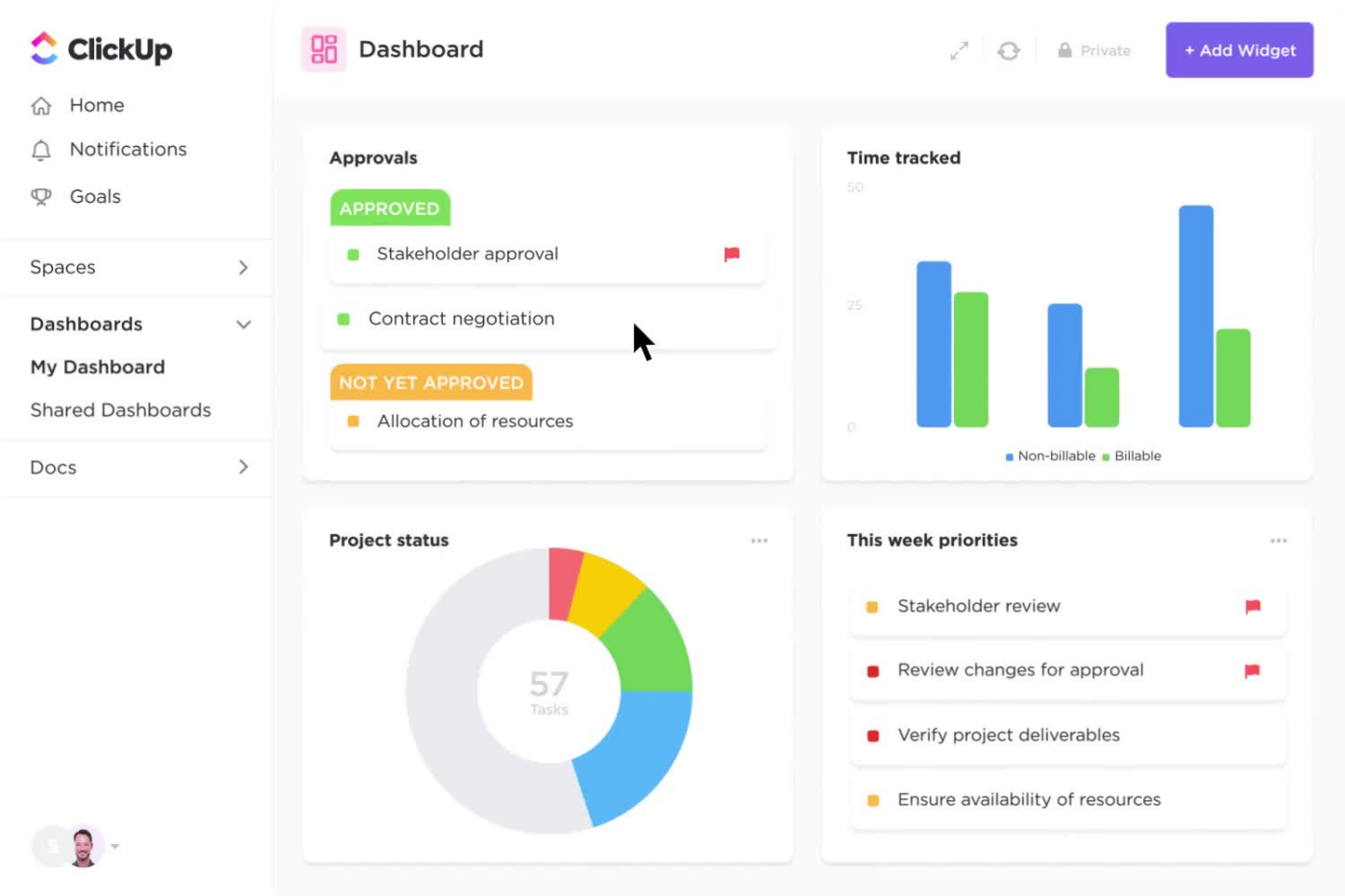The scope of work document is a simple yet necessary piece of the project management process.
As a project manager, it’s imperative that everyone involved in an upcoming initiative feels informed, heard, and included every step of the way. A scope of work (SOW) document is key to achieving this before the planning stage even ends.
Think of the scope of work as a tool—something you, the project team, and all key players will revisit multiple times throughout the project management process, and something that evolves as your timeline progresses.
Before opening a fresh document to embark on your scope of work writing process, consult this detailed guide to inform your framework.
Find detailed breakdowns, examples, and best practices for writing a valuable scope of work document. Plus, access a free scope of work template to standardize your process and contribute to alongside the team!
What is a Scope of Work?
The scope of work clearly defines the project controls, services, and deliverables you’ll provide in an upcoming project. It acts as a written agreement and is one of the most important and detailed documents in the early stages of any project.
With the right resources at hand, creating a scope of work document can be a fairly simple process! But it’s important to keep in mind its essential must-have elements to keep your team on the same page when it comes to:
- Project deliverables
- All necessary resources including budget, time, and workload
- Project timeline and phases
- Legal requirements
Specifying these factors early on will help you manage projects more successfully and avoid setbacks in your project schedule, running out of resources, or scope creep later in the project management process. Plus, a thorough scope of work ensures the project team knows exactly what’s expected of them, including the purpose of the project, overall spending, project milestones, and deadlines.
⭐ Featured Template
Nail down what’s in scope (and what’s not) with ClickUp’s free Scope of Work Template. Define tasks, timelines, and responsibilities before things get messy.
Best Practices When Writing a Scope of Work
Here’s your new scope of work mantra: When in doubt, be specific, visual, and fully transparent.
- Specific: What do the key terms mean? Who does what tasks and when? Being clear on project specifics is a surefire way to avoid confusion, miscommunication, and misalignment. All of which can be detrimental to a project’s execution
- Visual: What is the deliverable actually going to look like? Visuals help key players avoid misreading or misinterpreting project expectations from the start
- Transparent: Make sure the major stakeholders approve of what’s planned, acknowledge key milestones as they happen, and in general, stay in the loop
These three strategies will ensure you’re sending off the right information for any project, every time. But if you want to take them a step further, start investing your time more productively in the planning process by using a scope of work template to handle the heavy lifting when it comes to writing your scope of work.
How to Write a Scope of Work
Now that we’ve discussed best practices of a scope of work, let’s dive into how to write one. Here is a step-by-step list of how to write a scope of work:
- Define the project: Start by defining the project and its objectives. This should include what you are trying to achieve, why you are undertaking the project, and what benefits it will bring.
- List deliverables: Make a list of all deliverables that will be required for the project. This should include any documents, reports, software, or other items that will be needed.
- Determine tasks and timelines: Break down the project into smaller tasks and determine the timeline for each one. This should include start and end dates for each task and the overall project timeline.
- Identify resources: Identify the resources that will be required for the project, including personnel, equipment, and budget.
- Define quality standards: Outline the quality standards that will need to be met for the project. This should include any requirements for testing, quality control, and quality assurance.
- Determine communication procedures: Define the procedures that will be used for communication during the project. This should outline how often communication will take place, who will be involved, and what methods will be used.
- Identify risks: Identify any potential risks that could impact the project. This should include risks related to timelines, resources, quality, and other factors.
- Define acceptance criteria: Define the acceptance criteria that will be used to evaluate the success of the project. This should include specific metrics or measures that will be used to determine if the project has been completed successfully.
- Review and finalize: Review the scope of work with all stakeholders to ensure that it accurately reflects the project requirements. Once finalized, distribute the scope of work to all stakeholders and use it as a reference throughout the project.
Scope of Work Document Templates
Looking to standardize your planning practices? Start with a project management template to expedite the scope of work process. As a rule of thumb, your scope of work template should have at least these five sections built out to plug and play your project information:
- A glossary for relevant terms
- The problem statement your project is solving
- SMART goals, project objectives, deliverables, KPIs, and the like
- Necessary administrative needs and approvals
- A customizable project schedule or timeline
But TBH, these five sections are the bare minimum.
With the right document editor and template, you’ll also be able to collaborate on your scope of work alongside the team, customize the sharing and permission settings, connect the document to your workflows, and more. 👀
All of this is possible with the beginner-friendly Scope of Work Template by ClickUp—at absolutely no cost.
This detailed ClickUp Doc template comes organized in clearly formatted sections including:
- Background and project goals
- Deliverables
- Agency and client responsibilities
- Timeline and milestones
- Administration
- Approvals
Plus, thorough resource management planning and project objectives. 🏆
The sticky table of contents makes it easy to navigate the many sections of this document while the pre-built tables keep information concise and easy to grasp.

The greatest advantage of this template though is that it’s created using ClickUp Docs. Collaborative live detection and automatically-saved version history ensure that everyone with access is viewing the most recent version of the scope of work at all times. And since text can be converted directly into ClickUp tasks, team members can act on the project plan from the scope of work itself.

What’s more, ClickUp tasks can be embedded into Docs along with datasets from other software, so the necessary project information is never far from reach.
What to Include in a Scope of Work Document?
Let’s take a closer look at the essential elements of an effective scope of work document and best practices to adopt ahead of your next project.
Key deliverables
Are you providing a product or a service? Let the project team know! Even if it seems obvious to you, keeping a record of all project deliverables is helpful to keep on hand and refer back to later on. Plus, this document isn’t just for the project team—key players like stakeholders, other department heads, and higher-ups may be accessing this document as well, making the process of grasping the project scope critical.
Embedding images, diagrams, or media for context and additional visuals are a great way to convey details about your deliverables. Especially if your team creates wireframes using digital whiteboard software or uses specific reporting documents to break down your work structure, make that information as accessible as possible.
The option to embed information from other tools is a major benefit of using a dynamic document editor to manage your scope of work records, stakeholder approvals, SOPs, and more.

In ClickUp Docs, you have the power to embed virtually anything—including tasks, tables, media, assets from other tools, and more. With Slash Commands for quick keyboard shortcuts, collaborative live editing, rich formatting, and easy sharing via URL, ClickUp Docs are ideal for creating a thorough scope of work document with ease.
The project timeline
Your project management timeline is the start-to-finish journey of a project’s development. This section will outline the phases your project will pass through and detail the deliverables expected along the way.
You have to map out your timeline in order to define a project’s scope, but you can build your timeline in a variety of ways. Gantt charts, tables, and flowcharts like mind maps are highly visual project management solutions for creating your timeline and ensuring all major details are included. These resources are also excellent for identifying task relationships and dependencies which will make the project execution phase more efficient overall!

Gantt view in ClickUp makes it easy to achieve this level of time management with an intuitive drag-and-drop interface to draw relationships between tasks, visualize bottlenecks, and prioritize action items. Even calculate your critical path or track your progress percentages for a birdseye of what’s happening and what’s to come.
Major milestones
For complex projects especially, the timeline alone can be daunting. In these situations, it can be helpful to break up and define a larger timeline by its key deadlines when the project moves from one stage to the next. These major moments are known as project milestones.
Reaching a project milestone is a great opportunity to regroup, get back on the same page, and reassess where your project is headed. It’s the perfect time to touch back with important stakeholders and ensure the project is developing as expected or discuss any issues faced along the way.

Milestone templates help eliminate some of the guesswork involved in identifying the most significant milestones in a project while guaranteeing your team is making the best use of them. In ClickUp, Milestones are visually represented with a diamond-shaped icon on your timeline or Gantt chart. This helps you quickly identify your major achievements and can be created from any ClickUp task.
Progress reports
Reporting is not a one-and-done task on your list. Reliable insights and updated reports are key elements of any good scope of work document, as many managers and stakeholders will refer back to it multiple times throughout the project management process—not just the planning phase.
This is another area where it’s best to lean into more visual assets. No one wants to lose time deciphering lengthy datasets or clicking into additional research. Summarize the most important and data-driven points in a way that’s easy to digest.

Dashboards in ClickUp excel on this front. Choose from over 50 widgets to pull up-to-date data on recent project activities using customized charts, progress tracking, calculations, tables, and even other apps to build presentation-ready Dashboards for your projects.
Scope of Work Examples
To give you a more tangible understanding of how to write an effective Scope of Work, let’s delve into some real-life examples. These examples will illustrate how various organizations have successfully implemented their scope of work, providing you with practical insights and inspiration for your own projects.
1. Software Development Team Scope of Work
Project: Development of a Mobile App
- Objective: To design and develop a user-friendly mobile application for food delivery with unique features like live tracking and multiple payment options.
- Scope: The app should be compatible with both iOS and Android platforms. The project includes UI/UX design, backend development, testing, bug fixing, and deployment to the respective app stores.
- Timeline: The project will be completed in six months, with milestones set for each development phase.
- Deliverables: A fully functional mobile app, test report, user manual, and source code.
- Dependencies: Timely approval from stakeholders at each phase of development, availability of resources, and accessibility to third-party APIs for payment gateways.
2. Marketing Team Scope of Work
Project: Launch of a New Product
- Objective: To design and execute a comprehensive marketing campaign for the launch of a new line of organic skincare products.
- Scope: The project includes market research, competitor analysis, creation of marketing materials, social media promotion, PR, and tracking the success of the campaign.
- Timeline: The project will be carried out over four months, with specific deadlines for each task.
- Deliverables: A detailed marketing strategy, content for promotion (blogs, social media posts, press releases, etc.), and a final report outlining the campaign’s impact.
- Dependencies: Timely feedback and approval from the product team and stakeholders, collaboration with influencers, and market response.
3. HR Team Scope of Work
Project: Employee Onboarding Program
- Objective: To develop a comprehensive onboarding program that will help new hires become proficient in their roles quickly and feel welcomed into the organization.
- Scope: The project includes creating an onboarding checklist, developing training materials, organizing orientation sessions, and collecting feedback.
- Timeline: The project will take two months to complete with evaluation and revision periods included.
- Deliverables: An onboarding manual, training materials, and a feedback report.
- Dependencies: Timely input and cooperation from different departments, availability of new hires, and feedback from the new employees.
Scope of Work Samples for Other Use Cases
To make this process even simpler and more efficient, we’ve also created a set of ready-to-use templates for different use cases. Let’s dive into these templates and see how they can assist you in defining the scope of your projects.
Contractors: Having a scope of work is essential for contractors to define the expected deliverables and timeline. This document allows them to understand what needs to be done, when it needs to be done, and how it should be completed.
Marketing: Marketing teams need to have a scope of work in order to ensure that their projects are completed on time and with the expected quality. This document outlines the necessary steps for completing a project from start to finish, making it easier for team members to stay on track.
Set Your Scope of Work in Motion
So you’ve written your scope of work document, what now?
Easy—you connect it to your workflow in your project management software to start executing the plans you’ve now mapped out.

With over 15 unique views including Gantt, List, Kanban, Timeline, Calendar, and more, ClickUp makes it possible to visualize your work from every angle. Plus, its dynamic document editor ClickUp Whiteboard, and built-in Docs feature empower teams to act on their ideas the moment they happen.
No matter the size of your team, project style, or budget, ClickUp is the only productivity platform powerful enough to create wall-to-wall solutions for project managers across industries. Access every feature listed in this guide, a vast Template Library, and over 1,000 integrations when you start using ClickUp today.





